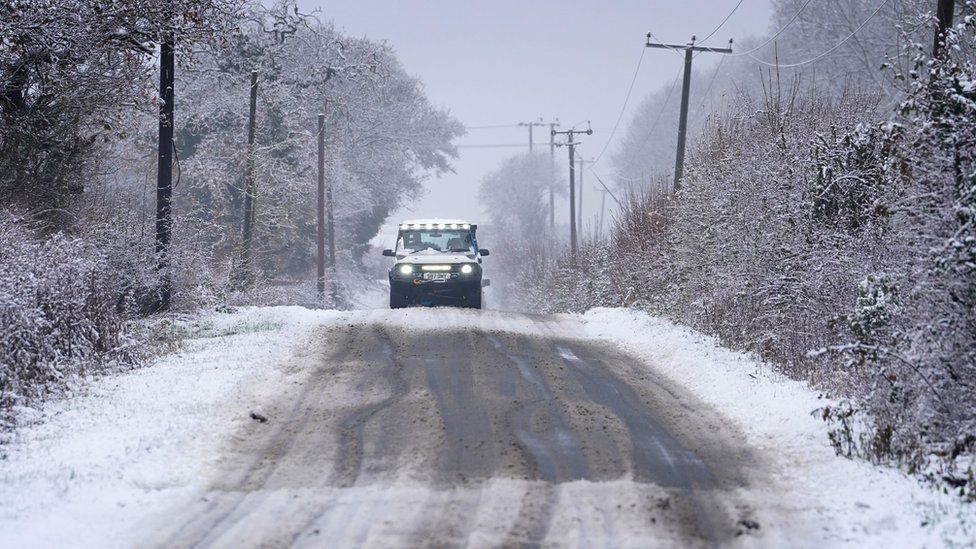 PA Media
PA MediaMotorists are being urged to plan and prepare before setting off in icy weather, after the UK saw its coldest night since February 2021.
Temperatures fell to a low of -17.3C (0.8F) overnight in Braemar in the Scottish Highlands.
Yellow warnings have been issued for the south-west and north-east coast of England as well as northern Scotland and parts of Northern Ireland.
The cold snap comes amid rail strikes, meaning more people may use cars.
Britain today is seeing a near total shutdown of its railways, with only about 20% of services expected to run. Further strike action is expected on Wednesday, Friday and Saturday.
This means many people will choose to drive to make the kind of journey they would normally do by rail – but in significantly more treacherous conditions than usual due to the cold weather.
The RAC is urging motorists to “plan, prepare and consider” before setting off.
How to drive safely on ice or in the snow
The RAC – or Royal Automobile Club – has issued some tips for drivers to stay safe on the roads:
- Plan your journey in advance, avoiding areas prone to flooding and ice
- Leave time to clear car windows, mirrors, lights and the top of your roof of snow before setting off
- Pack an emergency breakdown kit with the likes of a phone charger, food, drink, a blanket to keep you warm, a de-icer and a hi-vis vest in case you break down
- Accelerate gently, use low revs and change gear as quickly as possible
- Move off in second gear to reduce the risk of slipping
- Leave as much as 10 times the usual amount between you and other cars
- Brake before you turn the steering wheel when approaching a bend
- If you encounter a skid, steer gently in that direction
- Do not drive in the wheel tracks of other cars if the road as not been gritted
- Keep your speed significantly down to navigate icy roads
- Go into a higher gear to keep a grip on the ice to keep traction
The AA also said that it was crucial people do not give in to the temptation of pouring hot water on a frozen windscreen and driving off as this could crack the glass, or quickly freeze again on the screen.
Instead, the AA said you should turn on your car – ensuring the wipers are off to avoid damage – and then turn on the warm air blower on the windscreen. You should also turn on your rear windscreen heater, plus the air-con to ensure the windows do not fog up.
The next step is to clear any snow with a soft brush, before moving on to using a scraper and de-icer on the car.
The cold snap is due to last until the weekend in most places in the UK, and a Level 3 Cold Weather Alert issued by the UK Health Security Agency (UKHSA) covering all of England is currently in place until 09:00 GMT on Friday 16 December.
Under the cold weather alert, people are advised to look out for friends and family who may be vulnerable to the cold, and ensure they have access to warm food and drinks and are managing to heat their homes adequately.
Provisional data from the Met Office shows that the temperature in Braemar did not rise above -9.3C (15F) all day yesterday, making it the coldest day in the UK since December 2010.
Northern Ireland has an alert for fog lasting until Wednesday, while northern Scotland’s alert for snow is set to last to the end of the week.
England saw its coldest night of the year too, with -11.8C (10.7F) recorded at Redesdale in Northumberland.

Find out the weather forecast for your area, with an hourly breakdown and a 14-day lookahead, by downloading the BBC Weather app: Apple – Android – Amazon
The BBC Weather app is only available to download in the UK.

Rod Dennis from the RAC said their teams were “exceptionally busy” on Monday, helping more than 7,500 motorists with breakdowns. He added that this was 50% more than what they would see on a typical Monday in December.
